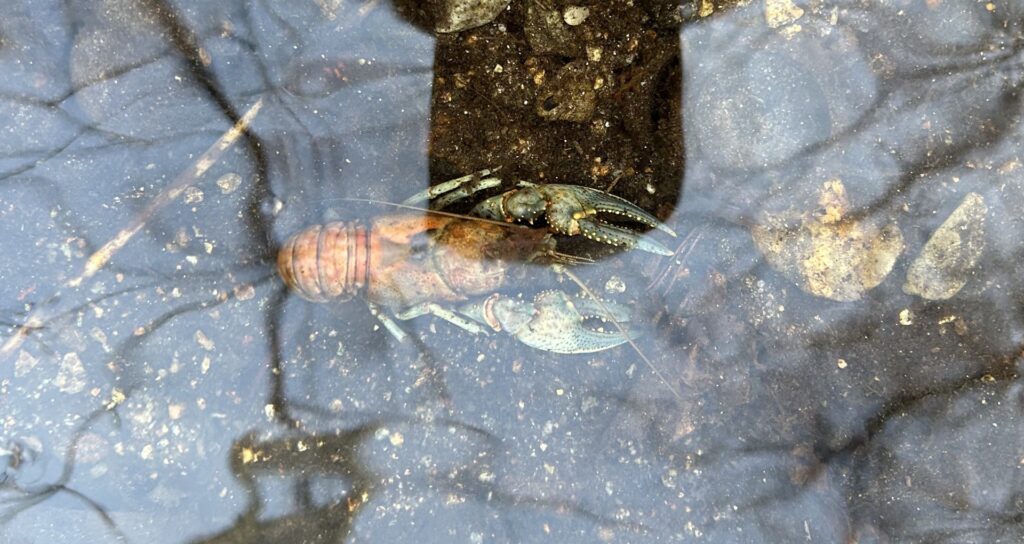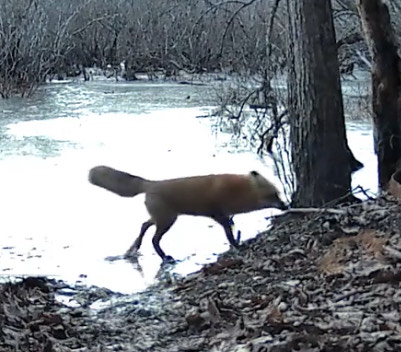December
December 15: A CRAYFISH scuttles across the gravel bottom of Nagog Brook, still free of ice cover. Kyran Vig, a student at Acton-Boxborough Regional High School who monitors stream depth weekly for the Green Acton Water Committee, noticed the crustacean next to the stream gauge. Biologists at OARS, MassWildlife, and Bridgewater State University think it is likely a virile crayfish.

Dec. 25: A hunting BOBCAT pauses on a log by a North Acton stream, intently watching something on the bank, then leaps and lands with an icy crunch, but catches nothing. [Note: color-highlighted text links to videos on Wildlife of Acton YouTube station photographed and curated by Rebecca Harvey.]
Dec. 26: A BOBCAT crosses a house patio on Heritage Road in South Acton, heading towards Fort Pond Brook.
Dec. 29: HORNED LARKS (74 birds) linger in School Street fields abutting Route 2, noted by spotters for MassAudubon’s 125th Christmas Bird Count. SNOW BUNTINGS (2) and LAPLAND LONGSPURS (2) accompany the flock on successive days.
Local CBC Coordinator Andy Magee reports, “The Acton/Littleton/Westford team (19 people in 8 field teams and 17 people at individual feeders) had a successful count this year – 50 species and 5,012 birds – about average for the last couple of years. The Acton area duck numbers were low because all the major water bodies were frozen, and the owl count was low—not sure what that was about.”
The three most numerous species spotted in our area were EUROPEAN STARLINGS (668 birds), CANADA GEESE (578) and DARK-EYED JUNCOS (568).
January
Jan. 2: RIVER OTTERS swim in ice-free North Acton brook, murmuring softly, and one plunges its head down with a loud splash.
Jan. 3: A RIVER OTTER steps onto thin ice and pauses to groom, scratching its neck and chewing its hip fur, before deliberately crashing loudly through the ice several times.
Jan. 5: A FOX steps onto the thin ice of a North Acton pond and its hind legs fall through the ice; the fox then scrambles up onto the dry earth bank.

Jan. 6: A FISHER pauses to rub its snout on a fallen log and sniffs the other side before moving on.
Jan. 19: A BALD EAGLE flies into a lone WHITE SPRUCE tree on Wright Terrace in West Acton and surveys Wright Hill.
Jan. 22: A FOX takes a mid-day stroll near Pratts Brook in South Acton.
Jan. 25: FORSYTHIA bushes shed abundant brown detritus flakes onto the snow [shedding sepals to make room for this year’s buds to grow?] in West Acton.
Jan. 27: In marshy woods abutting Martin Street in South Acton, birds in a group of over-wintering ROBINS call out [warnings?] to each other. Flying low through the woods, a RED-TAILED HAWK lands on a low branch, scanning a ditch carefully, then hops down into the ditch for a closer look. The hawk flies up to perch in a higher branch and a group of about a dozen MOURNING DOVES bursts up from the forest floor, their wings whistling loudly as they fly to the treetops about 50 feet from the hawk. Soon the doves fly away to the south, leaving the disappointed hawk behind.
Diners at West Acton bird feeders this month include black-capped chickadees, blue jays, blue birds, Carolina wrens, downy woodpeckers, house finches (one with signs of eye disease), gold finches, house sparrows, mourning doves, northern cardinals, red-bellied woodpeckers, starlings, slate-winged juncos, tufted titmouses, and white-throated nuthatches.
THANKS to this month’s Nature Watchers Dave Berglind, John Goreham, Rebecca Harvey, Andy Magee, Vicky Tabor, and Kyran Vig!
With sufficient response, we will publish the Acton Nature Watch in future months. Please send us your observations and photos to actonnaturewatch@gmail.com. We are curious about any wild animals, plants, and fungi within our borders. Witnessing so much healthy wildlife in our town makes us concerned about excessive use of second-generation anticoagulant rodenticides (SGARs). These chemicals pose a serious risk to all rodents (including beavers) and all predators, especially owls and hawks. Read Mass Audubon’s account of the sad end of a poisoned Belmont Great Horned Owl here. If you or your building’s property manager use a pest control company, ask them to use SGARs only as a last resort, and ask what other less harmful measures they have taken to exclude rodents from buildings and take away their food supplies.
Rob Gogan is a West Acton resident.
